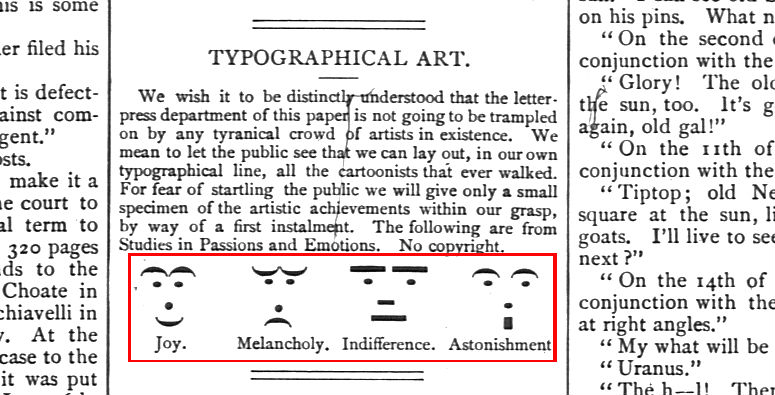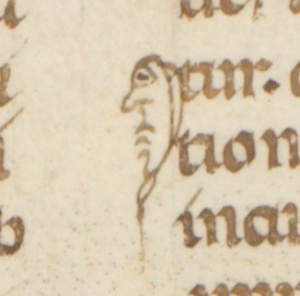This post was featured in L’actualité numérique [Digital News], a programme of the French national radio Le Mouv’ on Apr. 21, 2014.
When were emoticons invented? We have a few examples of typographical experimentations from the early 20th/late 19th century. Here’s a specimen from Edmond Morin’s Dictionnaire Typographique (1903).
But Morin was probably inspired by this 1881 issue of Puck magazine:
Media theorist Jussi Parikka describes these experiments as proofs of “the importance of the face before Facebook”, and links them to the work on human expressivity of French neurologist Guillaume-Benjamin Duchenne de Boulogne, who in 1862 published his treatise The Mechanism of Human Facial Expression. Interestingly, according to New York Times columnist Jennifer Lee, that was the very date when the now well-known “wink” smiley was first documented in the transcript of a speech by Abraham Lincoln.
Although subject to caution, this discovery promoted emulation to find even older examples of typographic patterns showing some resemblance to the modern smiley.On April 13, 2014, Levi Stahl found a 1648 poem by Robert Herrick bearing evidence of another emoticon:
Convinced? Blasé? Before someone comes up with a 15th century smiley hidden in an ancient incunabulum [or stretch the timeline even further, to include non-typographical examples like in the Addendum at the end of this post], I suggest you read this refutation by Alan Jacobs, maintaining that every quest for a pre-1980s emoticon is doomed to be a cultural impossibility, as smileys are embedded in a typewriter-computer technological continuum where text is displayed on screens, not on paper.
smileys, emoticons, typewriter art – Text Patterns – The New Atlantis
On one point, though, I disagree with Jacobs. He qualifies these “archeological attempts” as ahistorical. In my opinion, though, they are profoundly, irredeemably historical.
Indeed, like for recent hunts for the world’s first selfie (was it shot in 1892? or was it in 1838?), or for some chronologically inconsistent examples of “ancient social media”, today’s technology users are torn between their appetite for innovation, and the need for reassurance and continuity. They want to see themselves as protagonists of some major transformation, while at the same time finding a place in the great logbook of human history. There is nothing contradictory in this. On the contrary: because our technologies increasingly tend to surround themselves with an ideologically-dense halo of “disruption”, we crave for the comforting knowledge that we belong to a lineage of smiley-drawing, selfie-shooting, social media-consuming human beings.
Addendum [April 18, 2014]
After the publication of this post, some of my readers have suggested a few remarkable examples of ancient emotion-revealing conventional signs of textual nature. Although this would seem to be enough to match the definition of smiley, I’m afraid the fact that these signs where featured in manuscripts, and not in printed texts, leaves them out of our survey. But at least two strike as genuine historical curiosities.
The first one is presented by French-Swiss digital humanist Frederick Kaplan, who points to a 14th century codex (a copy of emperor Justinian’s Digestum Vetus, circa 533 AD).
The amanuensis who copied the text, introduced in the manuscript one small stylized face, maybe to mark a pause, to comment on the content of the text or to guide the reader’s intonation, in a context where clare legere (“reading aloud”) was more common than legere tacite (“reading silently”).
But the most striking example (or rather, the most outrageous claim) of ancient smiley-like suite of punctuation signs is suggested by a pseudonymous philologist/paleographist (?), Mlle Juls, who runs of a humorous scholarly tumblr. Possibly, a papyrus dating back to the 3rd century before our era displays mysterious )—-: signs, evocative of “sad smileys”.
The document, referenced as PHibeh I 13 (Hibeh Papyrus 13), is the excerpt of a treatise on music, excavated in 1902 and probably composed in 275 BC. Now there are a few caveats I have to mention here. The smileys have been highlighted in red, allegedly because otherwise they would be undetectable because of the poor quality of the image. Secondly, althouh the existence of the papyrus is attested, we don’t know if the image suggested by Mlle Juls actually comes from that document. Moreover, I don’t know personally Mlle Juls, and I cannot vouch for his/her claim. So keep in mind this could very well be a hoax. If it isn’t, that would officially make the Hibeh Papyrus the document containing the oldest proto-smiley (not an actual smiley, because manuscript and not printed) in history… or rather the oldest misunderstanding as to the expressive intention of an author 😛
![The archeology of smileys: futile, yet revealing of our craving for historical continuity [updated 21 Apr. 2014]](https://www.casilli.fr/wp-content/uploads/2014/04/herrick.jpg)





